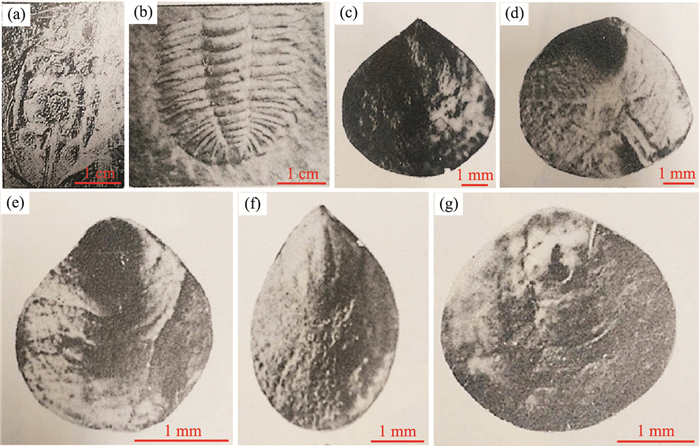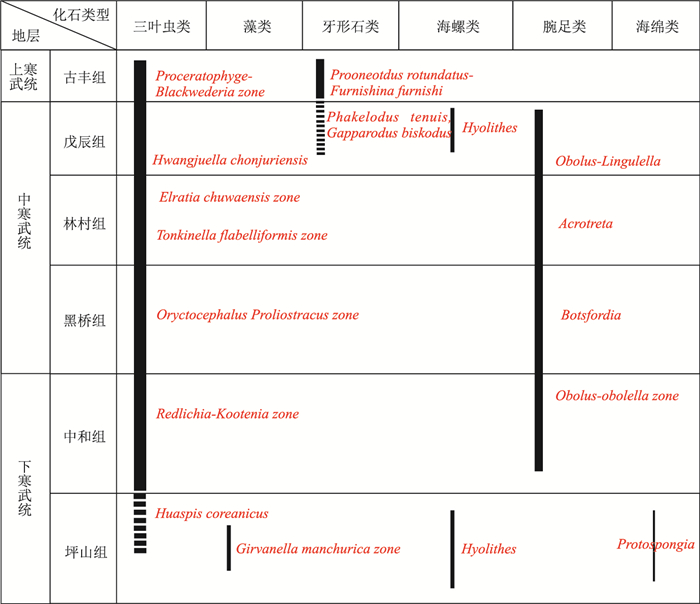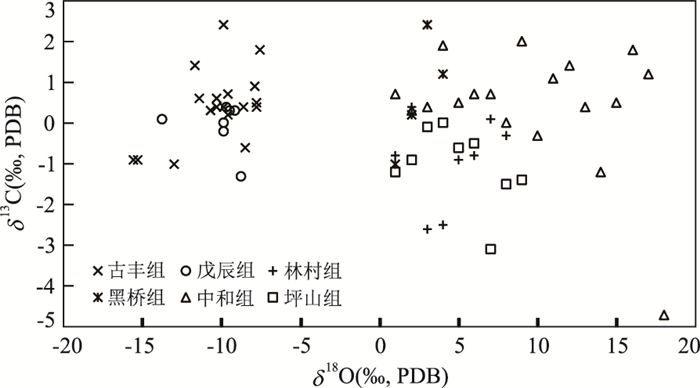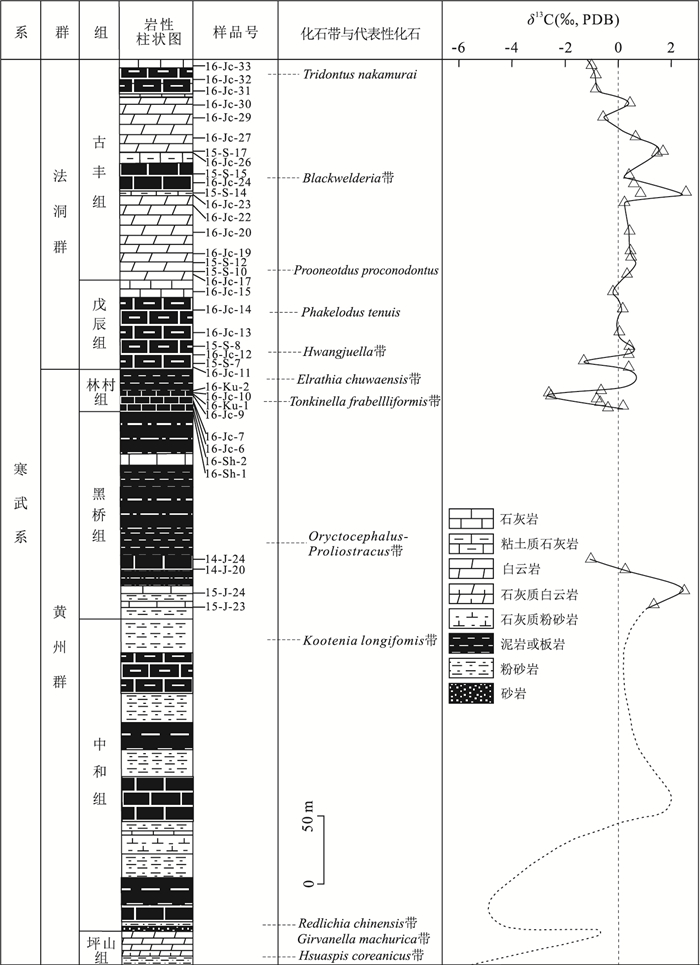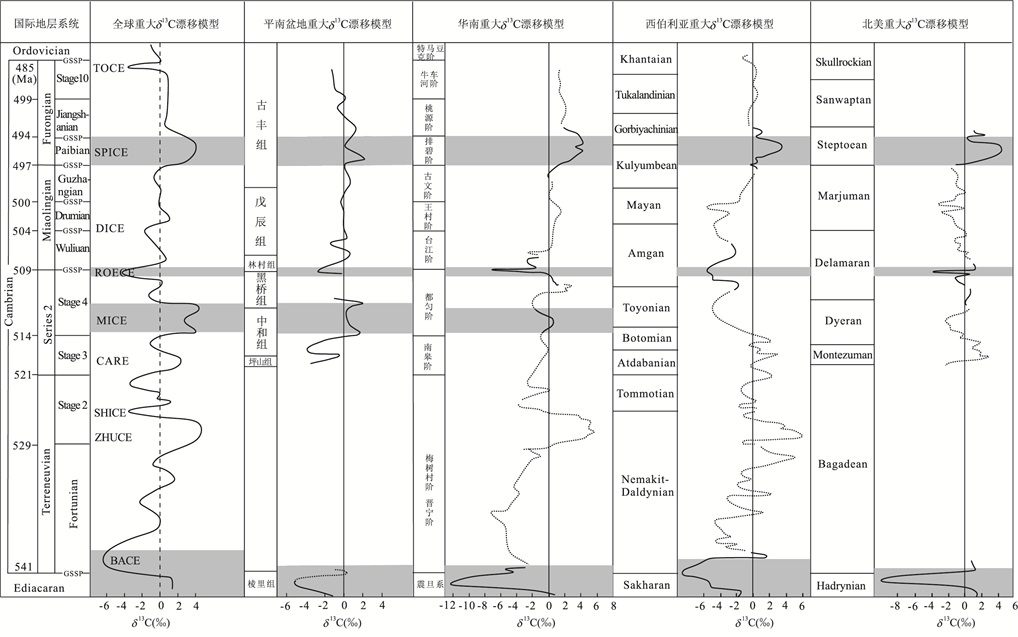Carbon Isotope Excursions of Cambrian Hwangju and Bopdong Groups in Pyongnam Basin, Korean Peninsula
-
摘要: 朝鲜平南盆地寒武系包括黄州群和法洞群下部.为了与邻区及世界其他地区同时期地层进行对比,对黄州群(从下到上分为坪山组、中和组、黑桥组和林村组)和法洞群下部(戊辰组和古丰组)进行了生物地层学和碳酸盐岩碳和氧同位素分析.生物地层学研究表明,坪山组和中和组分别不早于寒武系第三阶和第四阶.坪山组δ13C值变化范围为0~-3.1‰,中和组为-4.7‰~2.0‰,黑桥组为-1.0‰~2.4‰,林村组为-2.6‰~0.4‰,戊辰组为-1.3‰~0.4‰,古丰组为-1.0‰~2.4‰.综合对比分析,坪山组、中和组和黑桥组大致对应寒武系第三阶-第四阶,林村组大致对应第二统与苗岭统界线附近,古丰组大致对应芙蓉统.中和组上部-黑桥组(正漂移)、林村组下部(负漂移)和古丰组中部(正漂移)记录的3个碳同位素漂移事件可能分别对应MICE(mIngxinsi carbon isotope excursion)、ROECE(redlichiid-olenellid extinction carbon isotope excursion)和SPICE(steptoean positive carbon isotope excursion)全球性事件.Abstract: The Cambrian strata in the Pyongnam basin in Korea include the Hwangju Group and the lower Bopdong Group. To compare the Cambrian strata of this basin with those in the adjacent regions and areas beyond, this paper performs biostratigraphy research and isotope analysis of carbon and oxygen isotopes of typical carbonates of the Hwangju Group (the Pyongsan, Junghwa, Hukgyo and Rimchon Fms.) and the lower Bopdong Group (the Mujin and Kopung Fms.). Based on biostratigraphic research, the Pyongsan and Junghua Formations should be no lower than Stage 3 and Stage 4, respectively. δ13C values in the Pyongsan Fm. range from 0 to -3.1‰, Junghua -4.7‰ to 2.0‰, Hukgyo -1.0‰ to 2.4‰, Rimchon -2.6‰ to 0.4‰, Mujin -1.3‰ to 0.4‰, and Kopung -1.0‰ to 2.4‰. Synthetically, it is argued that the Pyongsan, Junghua and Hukgyo Fms. belong to Stages 3-4 of Cambrian, the Rimchon Fm. is around the boundary of Series 2 and Miaoling Series, and the Kopung Fm. belongs to the Furong Series of Cambrian. And the three carbon excursions in the upper Junghwa-Hukgyo Fm. (positive), the lower Rimchon Fm. (negative) and the middle Kopung Fm. (positive) are comparable to the global events of the mIngxinsi carbon isotope excursion, redlichiid-olenellid extinction carbon isotope excursion and steptoean positive carbon isotope excursion, respectively.
-
Key words:
- North China craton /
- Korean Peninsula /
- Pyongnam basin /
- Cambrian /
- carbon isotope excursion /
- biostratigraphy
-
图 2 平南盆地寒武系地层代表性三叶虫(a~b)和腕足类(c~g)化石照片
a.Hsuaspis coreanicus(中和组);b.Oryctocephalus longispinformis(黑桥组);c.Obolus margaritae(中和组);d.Botsfordia granulata(黑桥组);e.Obolus linyuensis(戊辰组);f.Lingulella tangshihensis(戊辰组);g.Acrothele asiatica(戊辰组).参见Paek et al.(1996)
Fig. 2. Representative fossils in the strata of the Cambrian in the Pyongnam basin
图 4 平南盆地寒武系碳酸盐岩δ13C-δ18O相关图
坪山组及中和组据金明哲等(2016)
Fig. 4. Correlation diagram of δ18O and δ13C of carbonates of the Cambrian carbonate rock in the Pyongnam basin
图 5 平南盆地寒武系地层柱状图及碳酸盐岩δ13C值变化
地层柱修改自Paek et al.(1996),地层总厚度约1 300 m.坪山组及中和组据金明哲等(2016)
Fig. 5. Cambrian strata column and variation of the δ13C values of carbonate samples in the Pyongnam basin
图 6 朝鲜平南盆地与华南、西伯利亚、北美等地寒武系碳酸盐岩同位素值变化对比
改编自樊茹(2011);坪山组及中和组数据金明哲等(2016)
Fig. 6. Comparison of carbon isotope of the Cambrian carbonates in the Pyongnam basin with those equivalents in South China, Siberia and Northern America
表 1 平南盆地寒武系碳酸盐岩的碳和氧稳定同位素组成
Table 1. Carbon and oxygen isotopes of the Cambrian carbonates from the Pyongnam basin
层位 岩石 样品号 13Ccarb
(‰, VPDB)18Ocarb
(‰, VPDB)古丰组 灰岩 16-Jc-33 -1 -13 泥质灰岩 16-Jc-32 -0.9 -15.3 泥质灰岩 16-Jc-31 -0.9 -15.6 白云岩 16-Jc-30 0.4 -8.6 白云岩 16-Jc-29 -0.6 -8.5 白云岩 16-Jc-27 0.6 -11.4 白云岩 15-S-17 1.8 -7.6 白云岩 16-Jc-26 1.4 -11.7 白云岩 15-S-15 0.4 -7.8 灰岩 16-Jc-24 0.6 -10.3 白云岩 15-S-14 0.9 -7.9 粘土质灰岩 16-Jc-23 2.4 -9.9 白云岩 16-Jc-22 0.2 -9.6 白云岩 16-Jc-20 0.4 -10.3 白云岩 16-Jc-19 0.4 -9.9 白云岩 15-S-12 0.5 -7.8 白云岩 15-S-10 0.7 -9.6 白云岩 16-Jc-17 0.3 -10.7 戊辰组 泥灰岩 16-Jc-15 -0.2 -9.9 粘土质灰岩 16-Jc-14 0.1 -13.8 粘土质灰岩 16-Jc-13 0 -9.9 灰岩 15-S-8 0.4 -9.7 粘土质灰岩 16-Jc-12 0.3 -9.5 灰岩 15-S-7 -1.3 -8.8 粘土质灰岩 16-Jc-11 0.3 -9.2 林村组 灰岩 16-Ku-2 -0.8 -11.5 灰岩 16-Jc-10 0.4 -14 灰岩 16-Ku-1 -2.6 -8.1 粘土质灰岩 16-Jc-9 -2.5 -12.1 粘土质灰岩 16-Jc-7 -0.9 -10.3 灰岩 16-Jc-6 -0.8 -12.6 灰岩 16-Sh-2 0.1 -10.4 灰岩 16-Sh-1 -0.3 -11.7 黑桥组 灰岩 14-J-24 -1.0 -11.7 灰岩 14-J-20 0.2 -16.9 灰岩 15-J-24 2.4 -10.5 灰岩 15-J-23 1.2 -8.8 -
Ahlberg, P., Axheimer, N., Eriksson, M.E., et al., 2006.High-Resolution Trilobite Biostratigraphy and Carbon Isotope Stratigraphy of the Middle Cambrian-Lower Furongian of Baltica.In: Jago, J.B., ed., Material of the 11th International Conference of the Cambrian Stage Subdivision Working Group.Geological Society of Australia Abstracts, South Australia, 5. Ameri, H., Zamani, F., 2016.Biostratigraphy of the Peri-Gondwana Cambrian Trilobite Fauna (Northern Kerman, Iran) and Correlation with Other Countries.Historical Biology, 28(3):331-346. https://doi.org/10.1080/08912963.2014.927870 Bartley, J.K., Pope, M., Knoll, A.H., et al., 1998.A Vendian-Cambrian Boundary Succession from the Northwestern Margin of the Siberian Platform:Stratigraphy, Palaeontology, Chemostratigraphy and Correlation.Geological Magazine, 135(4):473-494. doi: 10.1017/S0016756898008772 Berner, R.A., 2002.Examination of Hypotheses for the Permo-Triassic Boundary Extinction by Carbon Cycle Modeling.Proceedings of the National Academy of Sciences, 99(7):4172-4177. doi: 10.1073/pnas.032095199 Brand, U., Veizer, J., 1980.Chemical Diagenesis of a Multicomponent Carbonate System-1:Trace Elements.Journal of Sedimentary Research, 50:1219-1236. Brasier, M.D., 1984.Microfossils and Small Shelly Fossils from the Lower Cambrian Hyolithes Limestone at Nuneaton, English Midlands.Geological Magazine, 121(3):229-253. doi: 10.1017/S0016756800028296 Brasier, M.D, Sukhov, S.S., 1998.The Falling Amplitude of Carbon Isotopic Oscillations through the Lower to Middle Cambrian:Northern Siberia Data.Canadian Journal of Earth Sciences, 35(4):353-373. doi: 10.1139/e97-122 Brasier, M.D., 1993.Towards a Carbon Isotope Stratigraphy of the Cambrian System:Potential of the Great Basin Succession.Geological Society, London, Special Publications, 70(1):341-350. doi: 10.1144/GSL.SP.1993.070.01.22 Brasier, M.D., Corfield, R.M., Derry, L.A., et al., 1994.Multiple δ13C Excursions Spanning the Cambrian Exploration to the Botomian Crisis in Siberia.Geology, 22(5):455-458. doi: 10.1130/0091-7613(1994)022<0455:MCESTC>2.3.CO;2 Brasier, M.D., Shields, G., Kuleshov, V.N., et al., 1996.Integrated Chemo- and Biostratigraphic Calibration of Early Animal Evolution:Neoproterozoic-Early Cambrian of Southwest Mongolia.Geological Magazine, 133:445-485. doi: 10.1017/S0016756800007603 Buggisch, W., Keller, M., Lehnert, O., 2003.Carbon Isotope Record of Late Cambrian to Early Ordovician Carbonates of the Argentine Precordillera.Palaeogeography, Palaeoclimatology, Palaeoecology, 195(3-4):357-373. doi: 10.1016/S0031-0182(03)00365-1 Chang, C., Hu, W.X., Wang, X.L., et al., 2017.Carbon Isotope Stratigraphy of the Lower to Middle Cambrian on the Eastern Yangtze Platform, South China.Palaeogeography, Palaeoclimatology, Palaeoecology, 479:90-101. https://doi.org/10.1016/j.palaeo.2017.04.019 Choi, D.H., Kim, H.G., 1997.Stratigraphy and Lithofacies-Paleographic Properties of Lower Bed of Hwangju System, Hyonnae Area.Geoprosecting, 4:11-12 (in Korean with English abstract). Derry, L.A., Kaufman, A.J., Jacobsen, S.B., 1992.Sedimentary Cycling and Environmental Change in the Late Proterozoic:Evidence from Stable and Radiogenic Isotopes.Geochimica et Cosmochimica Acta, 56(3):1317-1329. doi: 10.1016/0016-7037(92)90064-P Dilliard, K.A., Pope, M.C., Coniglio, M., et al., 2007.Stable Isotope Geochemistry of the Lower Cambrian Sekwi Formation, Northwest Territories, Canada:Implications for Ocean Chemistry and Secular Curve Generation.Palaeogeography, Palaeoclimatology, Palaeoecology, 256(3):174-194.https://doi.org/10.1016/j.palaeo.2007.02.031 http://www.sciencedirect.com/science/article/pii/S0031018207003094 Emrich, K., Ehhalt, D.H., Vogel, J.C., 1970.Carbon Isotope Fractionation during the Precipitation of Calcium Carbonate.Earth and Planetary Science Letters, 8(5):363-371. doi: 10.1016/0012-821X(70)90109-3 Fan, R., Deng, S.H., Zhang, X.L., 2011.Significant Carbon Isotope Excursions in the Cambrian and Their Implications for Global Correlations.Science China Earth Sciences, 41(12):1829-1839 (in Chinese). http://www.cqvip.com/QK/60111X/201111/39816708.html Gill, B.C., Lyons, T.W., Young, S.A., et al., 2011.Geochemical Evidence for Widespread Euxinia in the Later Cambrian Ocean.Nature, 469(7238):80-83. http://www.wanfangdata.com.cn/details/detail.do?_type=perio&id=b5ff80f78d20a3b84652dd73ceee6c47 Glumac, B., Walker, K.R., 1998.A Late Cambrian Positive Carbon-Isotope Excursion in the Southern Appalachians:Relation to Biostratigraphy, Sequence Stratigraphy, Environments of Deposition, and Diagenesis.Journal of Sedimentary Research, 68(6):1212-1222. https://doi.org/10.2110/jsr.68.1212 Guo, Q.J., Strauss, H., Liu, C.Q., et al., 2005.Carbon and Oxygen Isotopic Composition of Lower to Middle Cambrian Sediments at Taijiang, Guizhou Province, China.Geological Magazine, 142(6):723-733. doi: 10.1017/S0016756805001202 Guo, Q.J., Strauss, H., Liu, C.Q., et al., 2010.A Negative Carbon Isotope Excursion Defines the Boundary from Cambrian Series 2 to Cambrian Series 3 on the Yangtze Platform, South China.Palaeogeography, Palaeoclimatology, Palaeoecology, 285(3):143-151. Hoffman, P.F., Kaufman, A.J., Halverson, G.P., 1998.Comings and Goings of Global Glaciations on a Neoproterozoic Tropical Platform in Namibia.GSA Today, 8(5):1-9. Hong, J., Cho, S.H., Choh, S.J., et al., 2012.Middle Cambrian Siliceous Sponge-Calcimicrobe Buildups (Daegi Formation, Korea):Metazoan Buildup Constituents in the Aftermath of the Early Cambrian Extinction Event.Sedimentary Geology, 253:47-57. http://d.old.wanfangdata.com.cn/NSTLQK/NSTL_QKJJ0226518840/ Høyberget, M., Bruton, D.L., 2008.Middle Cambrian Trilobites of the Suborders Agnostina and Eodiscina from the Oslo Region, Norway.Palaeontographica Abteilung a-Stuttgart-Band, 286(1-3):1-87. doi: 10.1127/pala/286/2008/1 Hu, B., Zhai, M.G., Li, T.S., et al., 2012.Mesoproterozoic Magmatic Events in the Eastern North China Craton and Their Tectonic Implications:Geochronological Evidence from Detrital Zircons in the Shandong Peninsula and North Korea.Gondwana Research, 22(3-4):828-842. doi: 10.1016/j.gr.2012.03.005 Ishikawa, T., Ueno, Y., Shu, D., et al., 2014.The δ13C Excursions Spanning the Cambrian Explosion to the Canglangpuian Mass Extinction in the Three Gorges Area, South China.Gondwana Research, 25(3):1045-1056. doi: 10.1016/j.gr.2013.03.010 Jong, H.S., Hong, S., Won, C.G., 2001.Some Species of Cambrian Conodonts Found Newly in Dongmyongwangrung Area.Bulletin of Kim Il Sung University, 47(1):138-141 (in Korean with English abstract). Jong, H.S., Won, C., 2002.The Distribution of Cambrian Conodont Fossils in Ryokpo Area.Bulletin of Kim Il Sung University, 48(12):98-102 (in Korean with English abstract). Kaufman, A.J., Jacobsen, S.B., Knoll, A.H., 1993.The Vendian Record of Sr and C Isotopic Variations in Seawater:Implications for Tectonics and Paleoclimate.Earth and Planetary Science Letters, 120(3/4):409-430.https://doi.org/10.1016/0012-821x(93)90254-7 http://www.sciencedirect.com/science/article/pii/0012821X93902547 Kaufman, A.J., Knoll, A.H., 1995.Neoproterozoic Variations in the C-Isotopic Composition of Seawater:Stratigraphic and Biogeochemical Implications.Precambrian Research, 73(1-4):27-49. https://doi.org/10.1016/0301-9268(94)00070-8 Kim, C.J., 2010.Lithosfacies-Paleogeography during Sedimentation of Vendian Period.Geological and Ore Deposit, 5:22-26. Kim, D.S., 1978.Some Species of Trilobita Newly Found from the Lower Part of the Middle Cambrian Widely Distributed in the Northern Part of Korea.Geology and Geography, 2:23-27 (in Korean with English abstract). Kim, D.S., 1982.Boundary Problems of the Middle Cambrian in Korea.Bulletin of Kim Il Sung University, 3:23-28 (in Korean with English abstract). Kim, M.C., Yang, J.H., Peng, P., et al., 2016.Characteristics of Carbon Isotope of the Ediacaran and Lower Cambrian Strata in the Pyongnam Basin, DPR Korea.Acta Petrologica Sinica, 32(10):3180-3186 (in Chinese with English abstract). http://d.old.wanfangdata.com.cn/Periodical/ysxb98201610017 Kim, Y.G., 1988.Stratigraphic Significance of Brachiopods from the Cambrian of Pyongyang Area.Geology and Geography, 3:29-31 (in Korean with English abstract). Kirschvink, J.L., 1992.Late Proterozoic Low-Latitude Global Glaciation:The Snowball Earth.The Proterozoic Biosphere, 52:51-52. http://d.old.wanfangdata.com.cn/Periodical/dsjyj200906006 Kouchinsky, A., Bengtson, S., Gallet, Y., et al., 2008.The SPICE Carbon Isotope Excursion in Siberia:A Combined Study of the Upper Middle Cambrian-Lowermost Ordovician Kulyumbe River Section, Northwestern Siberian Platform.Geological Magazine, 145(5):609-622. http://adsabs.harvard.edu/abs/2008GeoM..145..609K Kouchinsky, A., Bengtson, S., Missarzhevsky, V.V., et al., 2001.Carbon Isotope Stratigraphy and the Problem of a Pre-Tommotian Stage in Siberia.Geological Magazine, 138(4):387-396.https://doi.org/10.1017/s0016756801005684 http://www.wanfangdata.com.cn/details/detail.do?_type=perio&id=S0016756801005684 Kouchinsky, A., Bengtson, S., Pavlov, V., et al., 2007.Carbon Isotope Stratigraphy of the Precambrian-Cambrian Sukharikha River Section, Northwestern Siberian Platform.Geological Magazine, 144(4):609-618.https://doi.org/10.1017/s0016756807003354 doi: 10.1017/S0016756807003354 Krull, E.S., Retallack, G.J., Campbell, H.J., et al., 2000.δ13 Corg Chemostratigraphy of the Permian-Triassic Boundary in the Maitai Group, New Zealand:Evidence for High-Latitudinal Methane Release.New Zealand Journal of Geology & Geophysics, 43(1):21-32. http://xueshu.baidu.com/usercenter/paper/show?paperid=ffdd703f42bb34c0034563470ecad264&site=xueshu_se&hitarticle=1 Kwon, J.M., 2005.Paleogepgraphic Properties of Lower Paleozoic.Geoprospecting, 4:7-8 (in Korean with English abstract). Kwon, J.R., Park M.H., Won C.K., et al., 2010.Stratigraphy of Korea (2).Kim Il Sung University Press, 13-81 (in Korean with English abstract). Lindsay, J.F., Kruse, P.D., Green, O.R., et al., 2005.The Neoproterozoic-Cambrian Record in Australia:A Stable Isotope Study.Precambrian Research, 143(1-4):113-133. doi: 10.1016/j.precamres.2005.10.002 Maloof, A.C., Porter, S.M., Moore, J.L., et al., 2010a.The Earliest Cambrian Record of Animals and Ocean Geochemical Change.Geological Society of America Bulletin, 122(11-12):1731-1774. doi: 10.1130/B30346.1 Maloof, A.C., Ramezani, J., Bowring, S.A., et al., 2010b.Constraints on Early Cambrian Carbon Cycling from the Duration of the Nemakit-Daldynian-Tommotian Boundary 13C Shift, Morocco.Geology, 38(7):623-626. doi: 10.1130/G30726.1 Montañez, I.P., Osleger, D.A., Banner J.L., et al., 2000.Evolution of the Sr and C Isotope Composition of Cambrian Oceans.GSA Today, 10:1-7. Paek, R.J., Kang, H.G., Jon, G.P., 1996.Geology of Korea.DPR of Korea, Institute of Geology, State Academy of Sciences.Foreign Language Book Publishing House, Pyeongyang, 31-51. Parcha, S.K., 1999.Cambrian Biostratigraphy in the Tethyan Sequences of the Spiti Valley, Himachal Himalaya, India.Newsletters on Stratigraphy, 37(3):177-190. doi: 10.1127/nos/37/1999/177 Park, H.U., Zhai, M.G.Yang J.H., et al., 2016.Deposition Ages of the Sangwon Supergroup in the Pyongnam Basin (Korea) and the Early Tonian Negative Carbon Isotope Interval.Acta Petrologica Sinica, 32(7):2181-2195 (in Chinese with English abstract). Park, M.H., 2012.Geological Series of Korea (2).Industrial Publishing House, 309-363 (in Korean with English abstract). Park, M.H., Ri, S.B., Kim, C.G., 2001.Lithos-Paleogeography in the Period of Deposition of Solhwasan System Muckchon Series in the Upper Proterozoic Era.Bulletin of Kim Il Sung University, 9:160-163 (in Korean with English abstract). Paterson, J.R., 2005.Revision of Discomesites and Estaingia (Trilobita) from the Lower Cambrian Cymbric Vale Formation, Western New South Wales:Taxonomic, Biostratigraphic and Biogeographic Implications.Proceedings of the Linnean Society of New South Wales, 126:81-93. Peng, S.C., 2009a.Review on the Studies of Cambrian Trilobite Faunas from Jiangnan Slope Belt, South China, with Notes on Cambrian Correlation between South and North China.Acta Palaeontologica Sinica, 48(3):437-452 (in Chinese with English abstract). http://www.wanfangdata.com.cn/details/detail.do?_type=perio&id=gswxb200903015 Peng, S.C., 2009b.The Newly-Developed Cambrian Biostratigraphic Succession and Chronostratigraphic Scheme for South China.Chinese Science Bulletin, 54(18):2691-2698 (in Chinese). http://www.cqvip.com/Main/Detail.aspx?id=32198706 Peng S.C., 2014.Global Standard Stratotype-Section and Point (GSSP, "Golden Spike") and the GSSP Research in China.Earth Science Frontiers, 21(2):8-26 (in Chinese with English abstract). http://d.old.wanfangdata.com.cn/Periodical/dxqy201402002 Peng, P., Zhai, M.G., Li, Q.L., et al., 2011.Neoproterozoic (~900 Ma) Sariwon Sills in North Korea:Geochronology, Geochemistry and Implications for the Evolution of the South-Eastern Margin of the North China Craton.Gondwana Research, 20(1):243-254. doi: 10.1016/j.gr.2010.12.011 Ri, H., Ri, D.S., Won, C.G., 2009.On Some Species of Conodont Fossils Newly Found at Cambrian-Ordovician Boundary Strata in Resion Sopyong-ri Suan County.Bulletin of Kim Il Sung University, 55(3):186-188 (in Korean with English abstract). Ri, J.C., et al., 2010.Geological Series of Korea (5).Industrial Publishing House, 67-73 (in Korean with English abstract). Ripperdan, R.L., Magaritz, M., Nicoll, R.S., et al., 1992.Simultaneous Changes in Carbon Isotopes, Sea Level, and Conodont Biozones within the Cambrian-Ordovician Boundary Interval at Black Mountain, Australia.Geology, 20(11):1039-1042.https://doi.org/10.1130/0091-7613(1992)020<1039:scicis>2.3.co; 2 doi: 10.1130/0091-7613(1992)020<1039:SCICIS>2.3.CO;2 Saltzman, M.R., Ripperdan, R.L., Brasier, M.D., et al., 2000.A Global Carbon Isotope Excursion (SPICE) during the Late Cambrian:Relation to Trilobite Extinctions, Organic-Matter Burial and Sea Level.Palaeogeography Palaeoclimatology Palaeoecology, 162(3/4):211-223.https://doi.org/10.1016/s0031-0182(00)00128-0 doi: 10.1016-S0031-0182(00)00128-0/ Saltzman, M.R., Runnegar, B., Lohman, K.C., 1998.Carbon Isotope Stratigraphy of Upper Cambrian (Steptoean Stage) Sequences of the Eastern Great Basin:Record of a Global Oceanographic Event.Geological Society of America Bulletin, 110(3):285-297.https://doi.org/10.1130/0016-7606(1998)110<0285:cisouc>2.3.co; 2 doi: 10.1130/0016-7606(1998)110<0285:CISOUC>2.3.CO;2 Sanchez, B.E.B., Romero, F.J.C., Gonzalez, A.M., et al., 2017.The Echinoderm Gogia Granulosa (Echinodermata:Blastozoa) of Early-Mid Cambrian in Sonora, Mexico:Paleoecology and Paleogeography.Revista de Biologia Tropical, 65:160-167. doi: 10.15517/rbt.v65i1-1 Scholle, P.A., Arthur, M.A., 1980.Carbon Isotope Fluctuations in Cretaceous Pelagic Limestones:Potential Stratigraphic and Petroleum Exploration Tool.AAPG Bulletin, 64(1):67-87. Sundberg, F.A., McCollum, L.B., 1997.Oryctocephalids (Corynexochida:Trilobita) of the Lower-Middle Cambrian Boundary Interval from California and Nevada.Journal of Paleontology, 71(6):1065-1090.https://doi.org/10.1017/s0022336000036040 doi: 10.1017/S0022336000036040 Sundberg, F.A., McCollum, L.B., 2003.Early and Mid Cambrian Trilobites from the Outer-Shelf Deposits of Nevada and California, USA.Palaeontology, 46(5):945-986.https://doi.org/10.1111/1475-4983.00328 doi: 10.1111/pala.2003.46.issue-5 Veizer, J., Hoefs, J., 1976.The Nature of 18O/16O and 13C/12C Secular Trends in Sedimentary Carbonate Rocks.Geochimica et Cosmochimica Acta, 40(11):1387-1395. doi: 10.1016/0016-7037(76)90129-0 Walcott, C.D., 1913.The Cambrian Faunas of China, Research in China 3.Carnegie Ins Washington Publication, Washington D.C., 54:375. Wang, D., Ling, H.F., Ulrich, S., et al., 2016.Organic Carbon Isotope Stratigraphy of the Early Cambrian Huitong Section in Hunan Province, Southeastern Yangtze, China.Geological Journal of China Universities, 22(2):274-288 (in Chinese with English abstract). http://www.wanfangdata.com.cn/details/detail.do?_type=perio&id=gxdzxb201602007 Won, C.G., 2003.Cambrian Conodont Fossils Newly Found from Ryokpo Area.Geological Prospecting, 1:11 (in Korean with English abstract). http://www.ncbi.nlm.nih.gov/pubmed/15162732 Won, C.G., 2007.Observation on the Distribution of Cambrian Micropaleozoological Fossils of Kwail, Suan Areas.Bulletin of Kim Il Sung University, 53(10):171-173 (in Korean with English abstract). Won, C.G., Kim G.R., 2005.Micropaleozoological Fossils Newly Found from the Okrobong Beds of Junghwa Series in Hwangju Area.Geological Prospecting, 3:10-11 (in Korean with English abstract). Wotte, T., Álvaro, J.J., Shields, G.A., et al., 2007.C-, O- and Sr-Isotope Stratigraphy across the Lower-Middle Cambrian Transition of the Cantabrian Zone (Spain) and the Montagne Noire (France), West Gondwana.Palaeogeography, Palaeoclimatology, Palaeoecology, 256(1-2):47-70. https://doi.org/10.1016/j.palaeo.2007.09.002 Yang, A.H., Zhu, M.Y., Zhang, J.M., 2005.Stratigraphic Distribution and Palaeogeographic Control on the Early Cambrian Eodiscoids in Yangtze Platform.Journal of Palaeogeography, 7(2):219-232 (in Chinese with English abstract). http://www.wanfangdata.com.cn/details/detail.do?_type=perio&id=gdlxb200502007 Yang, Z.H., Peng, P., Jong, C.S., et al., 2016.Comparison on Ages of Detrital Zircons from the Paleoproterozoic to Lower Paleozoic Sedimentary Rocks in the Pyongnam Basin, Korea.Acta Petrologica Sinica, 32(10):3155-3179 (in Chinese with English abstract). http://d.old.wanfangdata.com.cn/Periodical/ysxb98201610016 Yang, R.D., Zhu, L.J., Wang, S.J., et al., 2002.Negative Carbon Isotope Excursion at the Middle-Lower Cambrian Boundary of Taijiang, Guizhou Province, China:Implication for Biological and Stratigraphical Significance.Science in China (Series D), 32(6):500-506 (in Chinese). http://www.wanfangdata.com.cn/details/detail.do?_type=perio&id=zgkx-cd200206007 Zhang, M.Q., Hong, J., Choh, S.J., et al., 2017.Thrombolite Reefs with Archaeocyaths from the Xiannüdong Formation (Cambrian Series 2), Sichuan, China:Implications for Early Paleozoic Bioconstruction.Geosciences Journal, 21(5):655-666. doi: 10.1007/s12303-017-0011-y Zhang, Q., Zhou, Z., 1985.Early Cambrian Trilobite Fauna of Kunshan, Jiangsu.Acta Palaeontologica Sinica, 24:259-266. http://www.wanfangdata.com.cn/details/detail.do?_type=perio&id=QK000000690030 Zhu, M.Y., Babcock, L.E, Peng, S.C., 2006.Advances in Cambrian Stratigraphy and Paleontology:Integrating Correlation Techniques, Paleobiology, Taphonomy and Paleoenvironmental Reconstruction.Palaeoworld, 15(3/4):217-222. doi: 10.1016-j.palwor.2006.10.016/ Zhu, M.Y., Strauss, H., Shields, G.A., 2007.From Snowball Earth to the Cambrian Bioradiation:Calibration of Ediacaran-Cambrian Earth History in South China.Palaeogeography, Palaeoclimatology, Palaeoecology, 254(1/2):1-6. doi: 10.1016-j.palaeo.2007.03.026/ Zhu, M.Y., Zhang, J.M., Li, G.X., et al., 2004.Evolution of Clsotopes in the Cambrian of China:Implications for Cambrian Subdivision and Trilobite Mass Extinctions.Geobios, 37(2):287-301. doi: 10.1016/j.geobios.2003.06.001 Zuo, J.X., Peng, S.C., Zhu, X.J., 2008.Carbon Isotope Composition of Cambrian Carbonate Rocks in Yangtze Platform, South China and Its Geological Implications.Geochimica, 37(2):118-128 (in Chinese with English abstract). http://www.wanfangdata.com.cn/details/detail.do?_type=perio&id=dqhx200802003 樊茹, 邓胜徽, 张学磊, 等, 2011.寒武系碳同位素漂移事件的全球对比性分析.中国科学:地球科学, 41(12):1829-1839. http://www.wanfangdata.com.cn/details/detail.do?_type=perio&id=QK201104047957 金明哲, 杨正赫, 彭澎, 等, 2016.朝鲜平南盆地埃迪卡拉系-下寒武统地层碳同位素特征.岩石学报, 32(10):3180-3186. http://d.old.wanfangdata.com.cn/Periodical/ysxb98201610017 彭善池, 2009a.华南斜坡相寒武纪三叶虫动物群研究回顾并论我国南、北方寒武系的对比.古生物学报, 48(3):437-452. http://d.old.wanfangdata.com.cn/Periodical/gswxb200903015 彭善池, 2009b.华南新的寒武纪生物地层序列和年代地层系统.科学通报, 54(18):2691-2698. http://www.wanfangdata.com.cn/details/detail.do?_type=perio&id=QK200901732506 彭善池, 2014.全球标准层型剖面和点位("金钉子")和中国的"金钉子"研究.地学前缘, 21(2):8-26. http://www.wanfangdata.com.cn/details/detail.do?_type=perio&id=dxqy201402002 朴贤旭, 翟明国, 杨正赫, 等, 2016.朝鲜平南盆地祥原超群的沉积时代与拉伸纪早期碳同位素负漂移.岩石学报, 32(7):2181-2195. http://d.old.wanfangdata.com.cn/Periodical/ysxb98201607018 王丹, 凌洪飞, ULRICH Struck, 等, 2016.湖南会同寒武纪早期有机碳同位素地层学研究.高校地质学报, 22(2):274-288. http://d.old.wanfangdata.com.cn/Periodical/gxdzxb201602007 杨爱华, 朱茂炎, 张俊明, 2005.扬子地台早寒武世古盘虫类的地层分布及其古地理控制.古地理学报, 7(2):219-232. doi: 10.3969/j.issn.1671-1505.2005.02.007 杨瑞东, 朱立军, 王世杰, 等, 2002.贵州台江中、下寒武统界线附近碳同位素负异常的生物和地层意义.中国科学(D辑):地球科学, 32(6):500-506. http://www.wanfangdata.com.cn/details/detail.do?_type=perio&id=zgkx-cd200206007 杨正赫, 彭澎, 郑哲寿, 等, 2016.朝鲜平南盆地古元古界-下古生界沉积岩碎屑锆石年龄谱对比及意义.岩石学报, 32(10):3155-3179. http://d.old.wanfangdata.com.cn/Periodical/ysxb98201610016 左景勋, 彭善池, 朱学剑, 2008.扬子地台寒武系碳酸盐岩的碳同位素组成及地质意义.地球化学, 37(2):118-128. doi: 10.3321/j.issn:0379-1726.2008.02.003 -










 下载:
下载:
